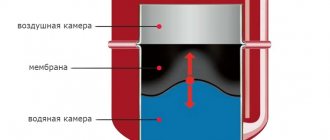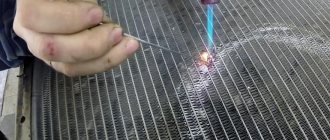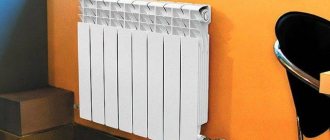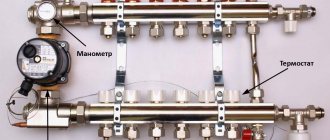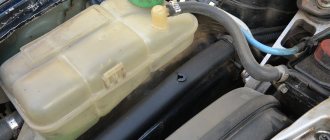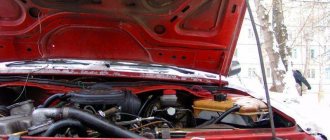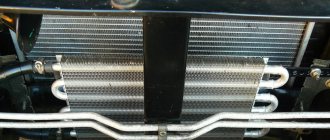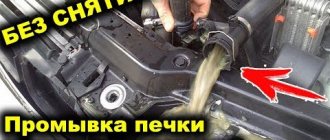Purpose of the radiator
Contrary to popular belief, a car cooling radiator performs several functions at once. His tasks include:
- Heat removal from product elements and its transfer to the atmosphere.
- Providing the possibility of adding and removing coolant (antifreeze, water, antifreeze) using special holes at the bottom and top.
- Creation of optimal pressure inside the system, thanks to the presence of a relief valve.
The main function of the radiator is to exchange heat and reduce the coolant temperature to a safe level.
Depending on the situation, cooling occurs by blowing with counter air or a fan, which starts when a certain temperature is reached. Depending on the make/model of the vehicle, the fan may be mechanical, electric, or hydraulic. The second option is considered the most popular.
Additional options
Depending on the design, the radiator of the cooling system can be supplemented with a separate compartment for cooling the automatic transmission oil - such a system allows you to effectively use the radiator airflow, performing two functions simultaneously. The technical specifications usually indicate whether the radiator is intended for additional cooling of transmission oil, or whether a separate cooling will have to be installed on the automatic transmission.
For cars with air conditioning installed, you need to select the appropriate radiator: it will be a little thinner, and the fastenings are made for a slightly greater distance to the front wall.
How does the engine cooling system work?
When considering a radiator, it is important to know the features of the car's cooling system, which is designed to reduce engine temperature to a safe level. In addition, its functions include heating the air, cooling the exhaust gases, the flow in the turbocharged system, as well as the oil in the automatic transmission. Structurally, the cooling system can be liquid, air or mixed. The most popular is the first option. Structurally, it consists of the following elements:
- Radiator. The main unit through which coolant passes to reduce the temperature.
- Water pump. Guarantees the circulation of working coolant throughout the system. It can be belt, gear or other types.
- Thermostat. Necessary to regulate the process of antifreeze passing through the radiator. It can have three positions - closed, partially / fully open.
- Fan. Triggered to increase airflow efficiency. Most often necessary when the car is moving at low speed and the air flow is not enough for cooling.
- Temperature sensor. Controls the temperature regime and gives a command when it is necessary to start additional cooling.
- ECU. The main unit that receives signals and regulates the operation of the car’s engine cooling system.
Depending on the car, other components may also take part in the operation, for example, an engine cooling relay, a heater, a thermostat, a fan control unit, etc.
Important
All elements interact closely with each other. So, after starting the engine, the coolant circulates using a pump in a minimal circle - through the block and cylinder head without passing through the radiator.
This is done for faster heating. As soon as the temperature reaches 80-90 degrees Celsius, the sensor is triggered and sends a command to open the thermostat.
In this case, antifreeze is directed through the radiator to maintain normal temperatures. If the engine continues to heat up, a signal is sent to turn on the fan, providing additional airflow.
Operating principle: convection vs. radiation
The operating principle of a heating radiator is extremely simple. Water, which has already been heated to the required temperature, flows from the boiler into the room through pipes. Then it enters the heating devices, which heat the air in the rooms of your home.
Convective heating radiator
It is worth noting that if heat is transferred by convection - this is accelerated heating of air that flows through the heating surface, then such a heating device will be called a convector. If heat is transferred by radiation, that is, heating of the surrounding air is produced by a surface that has an increased temperature and heat capacity, then this will be a radiator.
The operating principle of a heating battery can also have a combined form - panel radiators-convectors.
Considering how a heating battery works, it is worth noting that in order to quickly warm up a room, a convector is more suitable. However, such a cross-sectional heating battery has one drawback - due to the passage of active convection, a lot of dust is released into the air, which will not have the best effect on the health of those present. That is why convector batteries are used only where there are problem areas of the heating system. For example, to create an air curtain in a room with a large glass area, where conventional devices cannot fit in size.
Regardless of the temperature in the heating radiators, they will give off approximately 60 percent of the heat by radiating thermal energy, while the rest will be given off by convection. Thus, a minimum of hot air convection is achieved and those objects located in the room are well heated. In this regard, it can be noted that the way a radiator works is similar to a heated floor system.
Convectors or “in-floor” heating radiators
Types of radiators
Structurally, the devices under consideration differ in several criteria: assembly method, case material and additional elements. Taking into account the features, the price of a car radiator also differs. By design they are:
- Tubular-plate. They consist of tubes, inside of which so-called turbulators are mounted. This is done to lengthen the coolant path through the radiator and, accordingly, improve cooling. Such devices have greater rigidity and a minimal percentage of defects.
- Tubular-tape (soldered). Unlike the previous version, all elements are connected by soldering, which complicates the maintenance process. Such radiators have higher heat output and lower price.
There are two options based on the number of moves:
- One-way. Fluid flows in one direction.
- Two-way. The coolant path is more complex. First, the antifreeze passes through part of the tubes in one direction, and then in the second compartment it changes direction.
According to the material:
- Copper. More expensive. They are characterized by increased strength and better heat transfer. Easily repaired by soldering.
- Brass. They are rarely found in their pure form. Copper-brass structures are most often used.
- Aluminum car radiators. Appeared against the backdrop of rising copper prices. In production, modern welding methods are used, providing increased reliability and strength. Despite the worse heat transfer, such products cope with this task.
Today, all car engine radiators are made of aluminum. They have a lower price, but require a special approach to repair. For restoration, conventional soldering is not enough, because it usually has low efficiency. Argon welding is most often used.
Design features
When you choose radiators, there are several important points to consider. If you choose sections of radiators, you can increase the heating area if necessary. If the design of the heating radiator is panel, or it is a convector, then you will not change it structurally. When calculations are first made, it is very difficult to take into account all the nuances that will affect the amount of heat required for each individual room. And if the heating battery device is sectional, then this will make it possible to reduce and increase the number of sections, and replace those elements that have failed.
The cost of installing a heating radiator and installation rules
|
|
The heating radiator diagram is also characterized by an important aspect - the center distance, which displays the vertical distance between the centers of the inlet and outlet pipes. This point should be especially taken into account when an existing radiator or pipework is being replaced. If you buy a radiator with a different center distance, you will either have to change it or change the placement of the pipes.
The design of a heating radiator also means that it is important to consider the diameter of the pipes. If it is too small, it will cause the heating devices to clog faster.
After all, the quality of the coolant usually leaves much to be desired: the water contains sand, scale and rust. All these unpleasant moments when settling first cause the heating system to operate ineffectively, and then can even lead to its complete breakdown.
The correct choice of heating radiators is the most important nuance. A suitable sectional heating radiator is the key to good operation of the heating system.
Coolants
A coolant (liquid) moves inside the system, which, when passing through the radiator, is cooled and returned to the engine. Conventionally, all coolants are divided into several types:
- Distilled water. The most economical option that does not require the purchase of additional funds. It is used in the warm season, when there is no risk of the system freezing.
- Antifreeze is the old name for coolant used in the USSR. Previously, such compositions were poured into Zhiguli, but today they are almost never used.
- Antifreezes are modern coolants that contain special additives. They differ in terms of service life, corrosion protection features, the presence of additives and other features.
Conventionally, antifreezes are ethylene glycol, carboxyl, hybrid, lobrid and propylene glycol. They differ in characteristics, composition, set of additives and characteristics. For example, inorganic corrosion inhibitors are used in ethylene glycol compositions, and organic ones are used in carboxyl compositions. Hybrid and lobrid ones contain organic and inorganic components. As for propylene glycol coolants, they use safer propylene glycol.
The task of modern antifreezes is to remove heat, protect against corrosion and clean the car radiator from contaminants accumulated inside.
At the same time, the anti-corrosion function is considered the most important, and the effectiveness of this option directly affects the price. When choosing a coolant, you need to focus on the manufacturer’s recommendations in relation to the car brand.
A little history
The history of the creation of radiators goes far back, several thousand years ago, when people began to think about how to make their home warm and comfortable for living in the cold season. Then they heated themselves using an open fire, the smoke from which escaped through a special hole. The first heating battery appeared already in Ancient Rome in the form of a stove with a pipe. Interestingly, some modern houses still use this type of heating system to this day.
In 1855, German entrepreneur Franz San-Gali created the first cast iron radiator and called this device a “hot box”. The cast iron radiator has become widespread throughout the world and was used in steam heating systems. This was a serious start for new inventions in the field of heating. The first tubular steel radiator, invented by Rubert Zehnder, appeared in 1930. This discovery was a triumph. The battery was named Zehnder and demonstrated excellent technical characteristics: lighter weight than cast iron units and high heat transfer.
A little later, bimetallic radiators appear that combine both steel and aluminum, embodying all the advantages of steel and aluminum batteries. Subsequently, many companies mastered this technology, and it is still successfully used in the modern world for the production of radiators. Cast iron batteries came to Russia in the 20s, and already in the 40s all Soviet apartments had cast iron heaters. Aluminum and bimetallic radiators in Russia became popular much later than in Europe.
Damage, malfunctions and repairs
The radiator cannot be called the most reliable component of a car. During operation, it is affected by many negative factors, including mechanical ones. The most common damages include:
- Contamination of pipes and central part. In this case, flushing may be required.
- Fan damage.
- The accumulation of dirt and leaves on the outside of the product, which reduces heat transfer.
- Damage to the pipes or the radiator itself with subsequent leakage of coolant from the system.
- Corrosion of internal elements.
If any of the problems discussed above occur, there is a high risk of engine overheating, so the car’s radiator needs to be repaired. A sign of a breakdown may be the appearance of an antifreeze leak or rapid overheating of the engine during moderate operation.
The most difficult case is when the engine “boils” and steam starts coming out from under the hood. In this case, you need to stop and wait for the system to cool down. Only after this can you begin to troubleshoot the problem. If the problem occurs on the road, do the following:
- Check the tightness of the connections of all tubes.
- Make sure the cooling fan operates.
- Check relay wiring and temperature sensor.
- Add the required amount of coolant. Be careful as there is a high risk of hot liquid splashing.
It is better to entrust repairs to professionals. If it is not possible to go to a service station, you can use epoxy resin or “cold welding”. You must first drain the coolant from the system and remove the device from the car for easier access. There are other repair methods:
- Welding. Used when there is minor damage. Suitable for copper or brass devices. Requires a gas torch and degreaser. When performing argon welding on an aluminum “cooler”, aluminum wire is needed.
- Replacement. In a situation where the tube is damaged along its entire length, it will not be possible to solder the car radiator or weld the hole. The only way to solve the problem is to replace the old tube with a new one.
When deciding on the need and method of repair, it is necessary to assess the damage. In the most severe cases, the entire radiator may need to be replaced.
When should a replacement be made?
A car radiator is not a component that needs to be constantly replaced. This is a durable item that is unlikely to cause problems. However, you should be aware of the water level and its color. If the level is low, there may be a leak. In this case, replacement is recommended.
A very dark liquid with signs of rust is also not a good sign. Pay attention to the operating temperature of the engine, and if it starts to rise too much, contact a specialist. It is recommended to change the fluid every 30,000 km or 12 months.
Prevention and care
To extend the life of the product, proper care and regular maintenance are required. It is important to understand that the radiator absorbs all the dirt and dust and therefore needs to be flushed periodically. If nothing is done, the device quickly becomes clogged and stops performing its functions.
The main means of prevention is periodic flushing and cleaning of the car’s cooling system. You can do this yourself or entrust the work to a specialist.
| Stages of flushing a car's cooling system |
| 1. Allow the engine to cool, secure the hood and put on special gloves that do not allow water to pass through. |
| 2. Drain the antifreeze from the cooling system and fill it with distilled water |
| 3. Start the engine and leave it for 20-25 minutes |
| 4. Drain the liquid and repeat this procedure several times to completely clean the system. It is necessary to act until clean water begins to come out of the system. |
| 5. At one stage, add cleaning agent to the water to better clean the system. You can find special formulations on sale, for example, Winns Radiator Flush |
During operation, we must not forget that the radiator can become clogged from the outside. The pollutants are leaves, dirt, dust, etc. To solve the problem, you need to dismantle the product and blow it with air pressure or rinse it with a stream of water under high pressure. The main thing is not to overuse the pressure to avoid damaging the device’s cells.
After this, it is necessary to fill the system with high-quality antifreeze with a set of necessary anti-corrosion additives. To eliminate air locks, open the cap on the radiator and start the engine. After some time, the air will come out on its own, and all that remains is to add coolant to the system.
Repairing leaks
A more complex breakdown is considered to be eliminating an antifreeze leak. If this phenomenon is detected near the plastic pipe that goes into the radiator, you will not be able to solve the problem yourself. If cracks appear in the tubes of the device, they can be repaired using a special sealant.
In case of large-scale breakdowns (for example, after an accident), welding may be required. In some cases, a special substance can save the driver from replacing the radiator. It is called "cold welding".
Only connecting the radiator will help determine the quality of the repair work. Antifreeze is poured into the system and the engine is allowed to run for about 30 minutes. Only after this will it become clear whether the leak was eliminated.
Having considered what a radiator is, what functions and features it has, you can independently service the cooling system. Without sufficient experience, it is better to entrust such work to a specialist.
